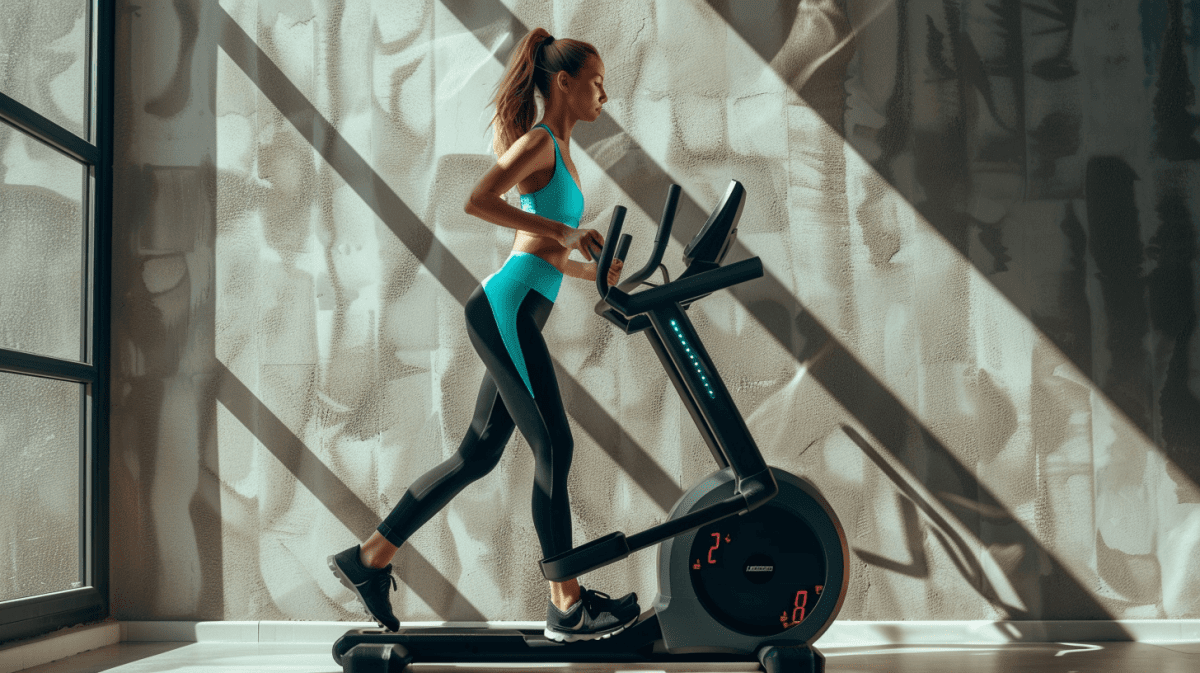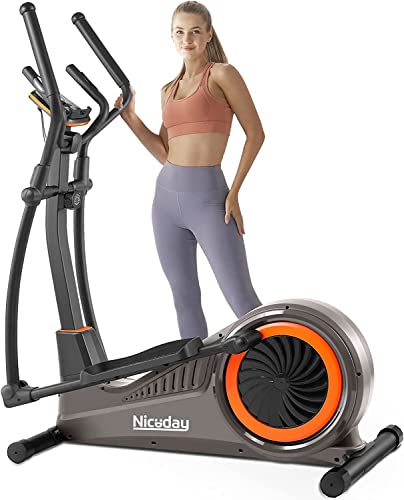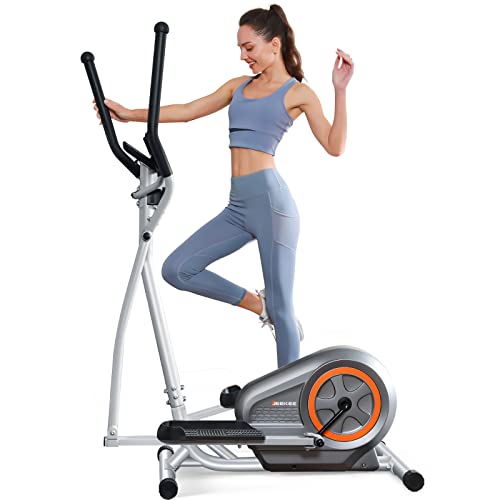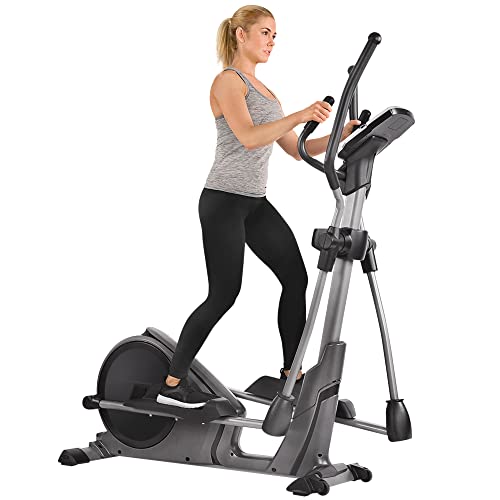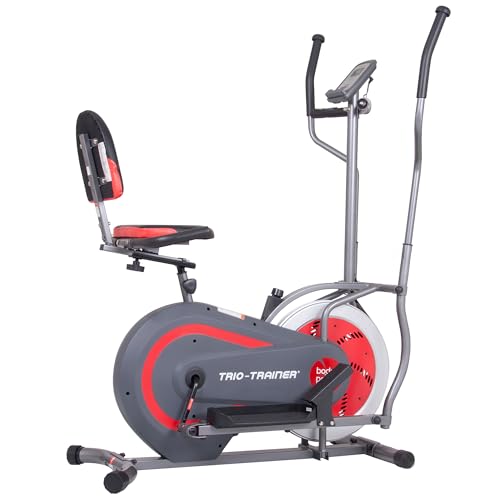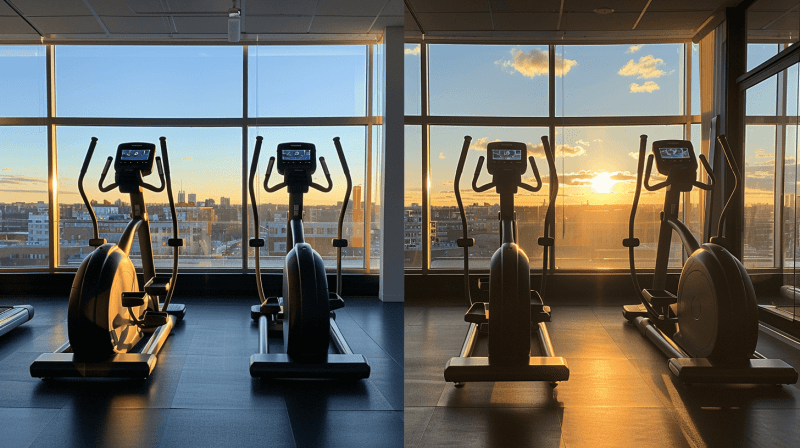When you're standing in front of an elliptical machine staring at the numbered resistance settings, you might wonder what level will give you the most effective workout without overwhelming your body. While there's no universal "perfect" setting that works for everyone, understanding how to choose the right resistance level can transform your cardio sessions from merely adequate to ideally beneficial. The sweet spot typically lies where you can maintain proper form while still feeling challenged, but several factors will influence your perfect setting - including your fitness goals, current conditioning, and even the specific make and model of the machine you're using.
Key Takeaways
-
Resistance levels 4-6 provide an effective baseline for most beginners while maintaining proper form and achieving a good workout.
-
Monitor your heart rate to stay between 65-85% of maximum capacity when choosing your resistance level.
-
Start with moderate resistance and gradually increase as your strength and endurance improve to prevent plateaus.
-
Different machine models have varying resistance scales, so focus on perceived exertion rather than specific numbers.
-
Match resistance to your goals: lower for endurance (4-6), higher for strength (7-10), and mixed levels for weight loss.
Understanding Elliptical Resistance Levels
Three key aspects make resistance levels on elliptical machines both helpful and potentially confusing for users. First, resistance levels vary tremendously between different machine models, as manufacturers don't follow standardized measurements. Second, the level of resistance directly impacts your workout intensity, and third, your physical condition determines which settings can help you achieve your fitness goals.
When you start your elliptical exercise, you'll notice you can set resistance levels manually or let pre-programmed workouts automatically adjust the resistance. This flexibility allows you to customize your low impact workout based on your fitness level and exercise objectives. You'll want to gradually increase resistance as your strength and endurance improve, while being mindful that higher isn't always better.
If you're new to elliptical training, start with a resistance level that allows you to maintain proper form for at least 20 minutes. When the resistance lowers too much, you might find yourself moving too quickly without proper control. Conversely, if you set resistance too high, you might struggle to complete your workout or compromise your form. Remember that different settings can help target various fitness goals, from endurance to strength building. The neuromuscular control benefits of elliptical training make it especially valuable for maintaining proper form while adjusting resistance levels.
Finding Your Starting Level
A well-chosen starting level on your elliptical machine sets the foundation for a sustainable fitness journey. For most people, beginning with resistance levels between 4 and 6 provides an effective balance that allows you to maintain proper form while getting a good workout. These moderate settings help you establish a baseline for your fitness routine without overwhelming your body or compromising your exercise technique.
To find your ideal starting point, you'll want to monitor your heart rate and perceived exertion during your workout. A good setting for people new to the elliptical trainer should allow them to maintain a conversation while exercising, indicating they're working within their target heart rate zone. If you're struggling to complete even a few minutes or finding it too easy to maintain your pace, adjust the resistance accordingly.
As your fitness improves, you can gradually increase the resistance levels to match your growing strength and endurance. While these guidelines provide a general framework, consulting with a fitness professional can help you determine the most appropriate resistance setting based on your weight, current fitness level, and specific exercise goals. Maintaining a tall upright posture throughout your workout will help ensure proper form and maximize the effectiveness of your chosen resistance level.
Heart Rate Based Training
While finding the right resistance level provides a foundation, monitoring your heart rate during elliptical training helps maximize your workout's effectiveness. You'll want to maintain your target heart rate between 65-85% of your maximum heart rate to achieve ideal cardiovascular fitness benefits. The elliptical's built-in heart rate monitoring features make it easy to track your intensity throughout your session.
To reach and sustain your preferred training zones, you can adjust both the resistance and incline settings on your machine. When your heart rate falls below your target range, try increasing either parameter. Conversely, if your heart rate climbs too high, you can decrease these settings to bring it back into the desired zone.
Consider incorporating interval training into your elliptical workouts to enhance both aerobic and anaerobic conditioning. You can alternate between periods of higher intensity, where you push your heart rate toward the upper end of your target zone, and recovery periods at a lower intensity. This approach not only improves your overall cardiovascular fitness but also increases the number of calories you burn during your workout.
A work-to-recovery ratio of 1:1 is recommended for optimal results during high-intensity interval training sessions.
Progressive Resistance Guidelines
Progressive resistance training on the elliptical machine demands a systematic approach to achieving your fitness goals. You'll need to identify your machine's resistance range and gradually increase the challenge level as your fitness levels improve, similar to the motion of cross-country skiing but with adjustable intensity.
To optimize your elliptical workouts, consider these key resistance guidelines:
- Start at a moderate resistance level that allows you to maintain proper form while keeping your heart rate in the target zone
- Incorporate HIIT workout segments by alternating between high resistance intervals and recovery periods
- Adjust the manual setting to higher resistance levels when focusing on building muscular strength
- Use moderate resistance for extended aerobic exercise sessions to build endurance
- Combine varied resistance levels throughout your workout to support weight loss goals
As you progress, you'll want to incrementally increase resistance to prevent plateaus and maintain effectiveness. Remember that progressive resistance training isn't about maxing out the machine's settings, but rather about finding the right balance that challenges your body while allowing you to maintain proper form and technique. A 150-pound person can expect to burn approximately 350 calories during a moderate 30-minute elliptical session.
Workout Goals and Settings
Setting the right resistance level on your elliptical machine directly impacts your workout effectiveness and goal achievement. You'll need to adjust your settings based on your specific fitness goals, while monitoring your heart rate to maintain apposite training intensity.
For endurance training, you'll want to keep your resistance level between 4-6, which should feel challenging but manageable during longer sessions. This moderate-intensity approach helps build your cardiovascular fitness while preventing early fatigue.
If muscle strength is your primary goal, you'll need to increase your resistance to levels 7-10. Perform intense intervals lasting 20-45 seconds to effectively build muscle power and enhance overall strength conditioning.
When focusing on weight loss, you'll benefit from combining moderate-intensity aerobic work with higher resistance intervals. This varied approach helps maximize calorie burn while keeping your body challenged in different ways. Remember that resistance levels can vary between elliptical machines, so you'll need to adjust accordingly, using lower numbers for less resistance and higher numbers for more challenging workouts. Always monitor your perceived exertion or heart rate to regulate you're working at the right intensity for your specific fitness goals. Maintaining proper elliptical technique with good posture and a smooth, even pace will help optimize your workout results regardless of the resistance level chosen.
Proper Form and Technique
Maintaining correct form on your elliptical machine is just as important as selecting the right resistance level. As you start moving, make sure you're standing tall with your core engaged and shoulders relaxed, which helps create a great full body workout while building strength. A personal trainer would emphasize that proper form prevents injury and maximizes your exercise benefits.
Keep these essential form elements in mind during your workout:
- Stand upright with your spine neutral, avoiding leaning on the handrails with little effort
- Keep your feet flat on the pedals, making full contact throughout each stride
- Engage your upper body by pushing and pulling the moving handles with purpose
- Maintain a resistance to keep your movements controlled, especially as your workout progresses
- Look straight ahead, not down at your feet, to safeguard your neck alignment
Your body should move smoothly and naturally through each stride, without bouncing or jerking motions. Focus on maintaining consistent form even when you're tired, as this guarantees you'll get the most benefit from your elliptical session while preventing strain on your joints and muscles. Consider incorporating interval training routines to add variety while maintaining proper technique throughout your workout.
Common Resistance Training Mistakes
When starting your elliptical workout, choosing the right resistance level often proves challenging for many users. One of the best ways to avoid common training mistakes is by properly entering your weight and starting with a manageable resistance, rather than immediately trying to match the intensity of sprinting on a treadmill.
Before lacing up those sneakers, understand that rushing into high resistance levels without proper progression can lead to poor form and potential injury. While some users relax when they're exercising, maintaining proper technique should always be your priority to provide a great full-body workout experience. Let's check your form regularly to keep you near your fitness goals while preventing compensatory movements.
If you find the elliptical challenging, you might try an exercise bike until you build adequate strength and endurance. Remember, it's an impact workout that burns calories effectively when done correctly, but only if you avoid common mistakes like skipping warm-ups or maintaining inconsistent training schedules. Focus on gradually increasing resistance over time, maintaining proper form, and following a structured progression plan to achieve ideal results and prevent training plateaus.
Frequently Asked Questions
What Is a Good Level on the Elliptical?
You'll find ideal resistance levels between 4-6 for endurance and 7-10 for strength training. Start with moderate intensity and gradually increase based on your fitness goals and comfort level during workouts.
What Setting Should I Put the Elliptical On?
Start with resistance levels 4-6 for endurance or 7-10 for strength. You'll know it's right when you can maintain your target heart rate while breathing steadily. Adjust based on your workout goals and comfort.
What Is Considered High Intensity on Elliptical?
You'll achieve high intensity on an elliptical when you're working at resistance levels 7-10, maintaining your heart rate at 80-90% max, or incorporating 20-45 second high-resistance intervals into your workout routine.
What Is a Good Pace on Elliptical?
You'll want to maintain 60-80 RPM for an ideal pace on the elliptical. Focus on comfortable foot positioning and proper form while staying within your target heart rate zone for efficient calorie burn.
Conclusion
Like adjusting the sails on an ancient ship, finding your ideal elliptical resistance level is a personal journey that'll evolve with your fitness progress. You'll want to start at level 4-6, monitoring your heart rate and form while gradually increasing intensity as you build strength. Remember, there's no one-size-fits-all approach - your suitable resistance level depends on your specific goals, current fitness level, and how your body responds to the workout.
